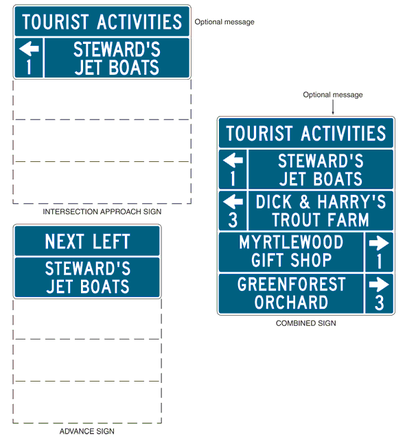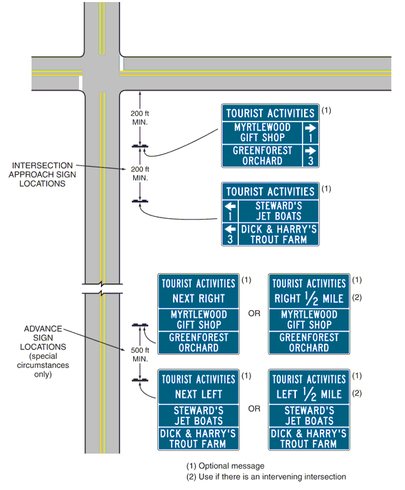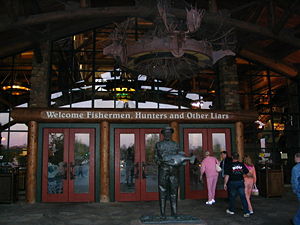Difference between revisions of "903.12 Tourist-Oriented Directional Signs (TODS)"
m (Per TS, updated links) |
m (Smithk moved page 903.12 Tourist-Oriented Directional Signs to 903.12 Tourist-Oriented Directional Signs (TODS): Per TS, clarified title) |
(No difference)
| |
Revision as of 09:51, 2 October 2020
Contents
- 1 903.12.1 Purpose and Application (MUTCD Section 2K.01)
- 2 903.12.2 Design (MUTCD Section 2K.02)
- 3 903.12.3 Style and Size of Lettering (MUTCD Section 2K.03)
- 4 903.12.4 Arrangement and Size of Signs (MUTCD Section 2K.04)
- 5 903.12.5 Advance Signs (MUTCD Section 2K.05)
- 6 903.12.6 Sign Locations (MUTCD Section 2K.06)
- 7 903.12.7 State Policy 7CSR 10-17 (MUTCD Section 2K.07)
903.12.1 Purpose and Application (MUTCD Section 2K.01)
Support. Tourist-oriented directional signs are guide signs with one or more sign panels that display the business identification of and directional information for eligible business, service and activity facilities.
This program is commonly referred to as the TODS Program. Pursuant to 7 CSR 10-17 of the Missouri Code of State Regulation (CSR), MoDOT has established provision noted in this chapter to carry out a program that “provides signing for qualifying attractions. These signs are erected in advance of at grade intersections on state system.”
This program is administered by an outside contractor and is governed by a set of rules and regulations that are contained in the Missouri CSR. The current CSR for the TODS program is contained in this chapter.
Standard. A facility shall be eligible for tourist-oriented directional signs only if it derives its major portion of income or visitors during the normal business season from travelers not residing in the area of the facility.
When used, tourist-oriented directional signs shall be used only on rural conventional roads and shall not be used on conventional roads in urban areas nor at interchanges on freeways or expressways.
Option. Tourist-oriented directional signs may be used in conjunction with EPG 903.10 General Service signs.
903.12.2 Design (MUTCD Section 2K.02)
Standard. Tourist-oriented directional signs shall have one or more sign panels for the purpose of displaying the business identification of and directional information for eligible facilities. Each sign panel shall be rectangular in shape and shall have a white legend and border on a blue background.
The content of the legend on each sign panel shall be limited to the identification and directional information for no more than one eligible business, service or activity facility. The legends shall not include promotional advertising.
Guidance. Each sign panel should have a maximum of two lines of legend including not more than one symbol, a separate directional arrow and the distance to the facility displayed beneath the arrow. Arrows pointing to the left or up should be at the extreme left of the sign. Arrows pointing to the right should be at the extreme right of the sign panel. Symbols, when used, should be to the left of the word legend or logo sign panel.
Option. The tourist-oriented directional sign may display the word message TOURIST ACTIVITIES at the top of the sign.
Standard. The TOURIST ACTIVITIES word message shall have a white legend in all upper-case letters and a white border on a blue background. If used, it shall be placed above and in addition to the directional sign panels.
Option. General Service sign symbols (EPG 903.10) and the symbols for recreational and cultural interest area signs (EPG 903.13) may be used.
Logo sign panels for specific businesses, services, and activities may also be used. Based on engineering judgment, the hours of operation may be displayed on the sign panels.
Standard. When used, symbols and logo sign panels shall be an appropriate size (see EPG 903.12.4). Logos resembling official traffic control devices shall not be permitted.
Support. Examples of tourist-oriented directional signs are shown in Figs. 903.12.2.1 and 903.12.2.2.
903.12.3 Style and Size of Lettering (MUTCD Section 2K.03)
Guidance. All letters and numbers on tourist-oriented directional signs, except on the logo sign panels, should be upper-case and at least 6 in. tall. Any legend on a logo should be proportional to the size of the logo.
Standard. Design standards for letters, numerals and spacing shall be as provided by Central Office Traffic.
903.12.4 Arrangement and Size of Signs (MUTCD Section 2K.04)
Standard. The maximum height of a tourist-oriented directional sign shall be 6 feet. Additional height shall be allowed to accommodate the addition of the optional TOURIST ACTIVITIES message provided in EPG 903.12.2 and the action messages provided in EPG 903.12.5.
Guidance. The number of intersection approach signs (one sign for tourist-oriented destinations to the left, one for destinations to the right and one for destinations straight ahead) installed in advance of an intersection should not exceed three. The number of sign panels installed on each sign is not to exceed four. The sign panels for right-turn, left-turn and straight-through destinations should be on separate signs. The left-turn destination sign should be located farthest from the intersection, and then the right-turn destination sign with the straight-through destination sign located closest to the intersection (see Fig. 903.12.2.2). Signs for facilities in the straight-through direction should be considered only when there are signs for destinations in either the left or right direction.
If it has been determined to be appropriate to combine the left-turn and right-turn destination sign panels on a single sign, the left-turn destination sign panels should be above the right-turn destination sign panels (see Figure 903.12.2.1). When there are multiple destinations in the same direction, they should be in order, based on their distance from the intersection. Except as provided in the second paragraph below, a straight-through sign panel should not to be combined with a sign displaying left- and/or right-turn destinations.
The sign panels are not to exceed the size necessary to accommodate two lines of legend without crowding. Symbols and logo sign panels on a directional sign panel are not to exceed the height of two lines of a word legend. All directional sign panels and other parts of the sign should be the same width, which should not exceed 6 feet.
Option. At intersection approaches where three or fewer facilities are displayed, the left-turn, right-turn and straight-through destination sign panels may be combined on the same sign.
903.12.5 Advance Signs (MUTCD Section 2K.05)
Guidance. Advance signs should be limited to those situations where sight distance, intersection vehicle maneuvers or other vehicle operating characteristics require advance notification of the destinations and their directions.
The design of the advance sign should be identical to the design of the intersection approach sign. However, the directional arrows and distances to the destinations should be omitted and the action messages NEXT RIGHT, NEXT LEFT, or AHEAD should be placed on the sign above the business identification sign panels. The action messages should have the same letter height as the other word messages on the directional sign panels (see Figures 903.12.2.1 and 903.12.2.2).
Standard. The action message sign panels shall have a white legend in all upper-case letters and a white border on a blue background.
Option. The legend RIGHT 1/2 MILE or LEFT 1/2 MILE may be used on advance signs when there are intervening minor roads.
The height required to add the directional word messages recommended for the advance sign may be added to the maximum sign height of 6 feet.
Guidance. The optional TOURIST ACTIVITIES message, when used on an advance sign, and the action message should be combined on a single sign panel with TOURIST ACTIVITIES as the top line and the action message as the bottom line.
903.12.6 Sign Locations (MUTCD Section 2K.06)
Guidance. If used, the intersection approach signs should be located at least 200 ft. in advance of the intersection. Signs should be spaced at least 200 ft. apart and at least 200 ft. from other traffic control devices.
If used, advance signs should be located approximately 1/2 mile from the intersection with 500 ft. between these signs. In the direction of travel, the order of advance sign placement should show the destinations to the left first, then destinations to the right, and last, the destinations straight ahead.
Position, height and lateral offset of signs should be governed by EPG 903.2.18 except as permitted in this article.
Option. Tourist-oriented directional signs may be placed further from the edge of the road than other traffic control signs.
Standard. The location of other traffic control devices shall take precedence over the location of tourist-oriented directional signs.
903.12.7 State Policy 7CSR 10-17 (MUTCD Section 2K.07)
Guidance. The rules and regulations for the Tourist Oriented Directional (TODS) Program, including guidelines for its administration, are available at the Code of State Regulations.
903.12.7.1 Contractor’s Role
Support. It is the contractor’s role to administer the day-to-day operations of the TODS program. The current contractor for this program is Missouri Logos, Inc. Missouri Logos makes contacts with prospective customers, proposes sign layouts for MoDOT review and arranges for the erection of new signs.
903.12.7.2 MoDOT’s Role
Support. MoDOT’s primary role in the TODS program should assure that sign installations follow our guidelines. Missouri Logos will provide the district a proposed layout of any new sign installation.
Guidance. District traffic personnel should field check each installation to be sure there is sufficient spacing for the signs and they do not interfere with any existing signs. Any requests for TODS signing should be referred to Missouri Logos for handling. Missouri Logo’s phone number (573) 893-6662.
903.12.7.3 Maintenance
Support. Missouri Logos is responsible for the initial erection of the TODS signs and panels. After the initial installation, the maintenance of the sign panels and logos remain the responsibility of Missouri Logos.


